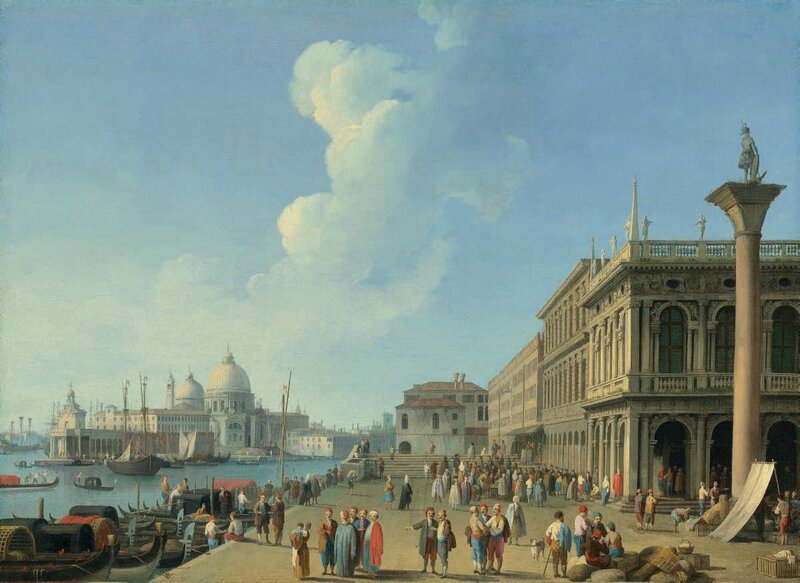Giovanni Battista Cimaroli, The Riva degli Schiavoni, Venice,... & The Piazzetta San Marco, Venice,...
Lot 150. Giovanni Battista Cimaroli (Saló 1687-after 1753 Venice), The Riva degli Schiavoni, Venice, with figures near the Libreria and column of Saint Theodore, the Punta della Dogana and Santa Maria della Salute beyond; and The Piazzetta San Marco, Venice, looking at the Molo, with the Libreria, the columns of Saints Mark and Theodore and figures conversing on the square, oil on canvas, each 24 ¾ x 33 ¾ in. (62.7 x 85.7 cm.), a pair. Estimate $300,000 - $500,000. Price Realized $317,000. Photo Christie's Image Ltd 2016
Provenance: Private collection, France.
Literature: F. Spadotto, Giovan Battista Cimaroli, Rovigo, 2011, pp. 252-253, nos. 87, 87a.
Note: These warmly colored views, painted in Cimaroli’s fluent, elegant brushwork, show two of the most iconic Venetian vistas made famous by Carlevarijs and Canaletto. The first is taken along the Molo looking west, with the column of St. Theodore set in the foreground against the Libreria Sansoviniana. This magnificent flowering of High Renaissance architecture was Jacopo Sansovino’s finest achievement, and was deemed by Palladio to be the most beautiful building since antiquity. Across the water at left appear the Punta della Dogana and, rising like a mirage from the surface of the Lagoon, the church of Santa Maria della Salute, the masterpiece of Baldassare Longhena that was built between 1631 and 1687 to commemorate the Virgin’s deliverance of the city from the plague of 1630. Along the Molo, from left to right, are the Republican Granaries (pulled down around 1814 to make way for public gardens) and the rusticated Doric façade of the Zecca (Mint), finished in 1547 by Sansovino on the site of the original 13th-century building.
The second vista looks southward from the Piazzetta, its two granite columns dedicated to Venetian patron saints Mark and Theodore framing a stretch of the promenade along the Riva degli Schiavoni. At this angle, the eastern façade of the Librearia is bathed in sunlight, so that a viewer can properly appreciate the statues by Lombardo, Ammannati, Vittoria, and others that seem to stand guard over it. Beyond the expanse of water in the distance at left appears the island of San Giorgio Maggiore, whose Benedictine church was built by Palladio in 1565 on classical models. To the left is the Giudecca with the church of Le Zitelle (Santa Maria della Presentazione), which was designed by Palladio c. 1570 but completed after his death in 1582-1586. Both pictures are enlivened by lively groups of exotic merchants, elegantly dressed ladies in Carnival masks, politicians, fishermen, children and dogs, aptly conveying the hustle and bustle of maritime activities in the harbor.
Giovanni Battista Cimaroli was as an early collaborator of Canaletto’s, specializing in Venetian views as well as rustic landscapes sympathetic to the style of Francesco Zuccarelli. Cimaroli’s considerable reputation was recognized in his lifetime: upon his arrival in Venice in 1726, he was commissioned by the Irish art agent Owen McSwiney on behalf of the 2nd Duke of Richmond to paint a series of Allegorical Tombs of British Worthies in collaboration with Canaletto, Piazzetta, and Pittoni, among other leading artists. Four oval landscapes by Cimaroli were selected by Consul Joseph Smith, Canaletto’s greatest patron, as part of an exclusive group of pictures sold to George III. Three of these works remain in the Royal Collection at Buckingham Palace (see F. Spadatto, op. cit., nos. 14, 14a, 14b.). Best known for his imaginary views, the present works are among only a few securely identifiable examples of the artist’s work in the veduta genre.
Christie's. OLD MASTERS: PART I, 14 April 2016, New York, Rockefeller Plaza

/https%3A%2F%2Fprofilepics.canalblog.com%2Fprofilepics%2F1%2F0%2F100183.jpg)
/https%3A%2F%2Fstorage.canalblog.com%2F03%2F02%2F119589%2F96711876_o.jpg)
/https%3A%2F%2Fstorage.canalblog.com%2F11%2F31%2F119589%2F94773502_o.jpg)
/https%3A%2F%2Fstorage.canalblog.com%2F20%2F83%2F119589%2F94772815_o.jpg)
/https%3A%2F%2Fstorage.canalblog.com%2F26%2F72%2F119589%2F75604929_o.jpg)
/https%3A%2F%2Fstorage.canalblog.com%2F59%2F60%2F119589%2F26458628_o.jpg)




/http%3A%2F%2Fstorage.canalblog.com%2F51%2F34%2F119589%2F69595169_o.jpg)
/image%2F1371349%2F20240425%2Fob_c453b7_439605604-1657274835042529-47869416345.jpg)
/image%2F1371349%2F20240425%2Fob_59c6f0_440358655-1657722021664477-71089985267.jpg)
/image%2F1371349%2F20240425%2Fob_07a28e_440353390-1657720444997968-29046181244.jpg)